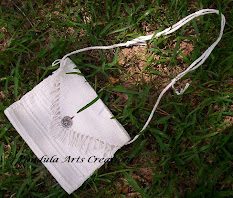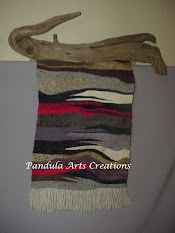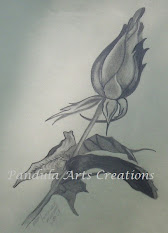January 18, 2012
I thought I would just throw out some of my experience's on the learning curve of Pine needle basket weaving.
One of the things I think needs clarification is the name "Pine Needle Basket Weaving". Notice how I always place the word 'coiling' after 'weaving', the reason for this is that there is no actual WEAVING going on here. I can't even imagine how it got that name.
In reality it is coiling and stitching, more akin to sewing than anything else...maybe embroidery and cross stitch as the stitches are decorative. This is why I always differentiate this title. I have only seen one book that clarifies that this is not weaving, there is no over and under, only stitching and feeding more pine needles into the coil. The method is actually very simplistic, the rest is all design element. That is why the resulting basket is so very personally related to the person constructing it. This is also in all probability why I love it so very much.
The tools are minimal, and are usually already on hand, especially if you are artsie fartsie (crafty) at all.
You need pine needles (I collect them myself and use rubber bands to bundle them with all of the heads at the same end), of course, a needle, and thread (or even raffia)at a minimum. Some people dampen the pine needles to start with, and then wrap them in a towel to keep them moist. A couple of times mine molded, and so I don't dampen them any more. I us center's for most of my baskets that are large enough that I don't need the pine needle to bend to the point that it cracks or breaks. I also find that I get a firmer basket if I use them dry.
I also use a gauge (a piece of cut ink pen tube, sometimes a piece of a drinking straw), a pin cushion, a small pair of pliers, scissors, wax or thread heaven, something for trash, a container for my tools (glad ware, wicker basket or tool box even), a container for the pine needles (glad-ware again), a thimble (I keep a medal one and leather one on hand), a glove for my right hand (Playtex cleaning glove with the fingers cut off at the tip, when tightening up the stitches it is easy to cut yourself, like a paper cut, with the thread without this glove) .
So here are a few pictures to help clarify.
First off, my friend Dana sent me some Long Leaf Pine needles from Georgia. I knew the ones I have found here in FL so far were smaller but ... OMG. Check it out. Not only are they longer but the difference in thickness is incredible. The Long Leaf are heavier, say a #3 crochet thread size, and the ones I gather here are more like a #10 thread size. Amazing.
They both work equally well, I just have to feed more pine needles in more often with the smaller ones. Mine are somewhere between 8 to 10 in long, and the Long leaf between 14 and 16 in. long. God love Dana for send them, and I hope to receive more. They are expensive to buy by the way.
So here I will post a pic of some of my tools. This is part of the left hand glove that would have been discarded. This way I don't waste it and I can double up on thickness. These are the fingers that get the most cuts from the threads.
This is the second layer of glove.
Home made pin cushion (steel wool wrapped with burlap in an old cheese tin), plyers, wax, thimble, scissors, #10 thread (I double it because it breaks when I don't) and a started basket. Notice the gauge and the sliced Poplar center. I had a friend cut and drill these for me months ago so that they could cure. I don't care for the poplar as I see no grain, live and learn.
Glad-ware with de-capped needles ready to go. Some were picked green and dried indoors to retain their green color. Eventually they were brown up just as the others that were dried outside will do. I think I recall reading that if you Shellac or varnish the basket they colors stays green...but I like the Pine scent so the most I have done is spray a little matte fixative on a basket. I find I like my method of waxing the thread and then melting it in the microwave is more to my liking. Makes the house smell wonderful also.
I save and use tins alot. The round one holds my rubber bands, one has needles, one has wax. You get the idea. And then we see the gauge at work, this one is an ink pen tube cut to size.
And that, my friends, is my way of making pine needle baskets.
I have taken to walking my dogs in the afternoons to scour out supplies, and low and behold yesterday I found a small stand of bamboo. The lady who owns the property says have at it, so today I cut some small bamboo to work into this process. I am also going to add in some palm frond and vines...so stay tuned.
Same bat time, same bat channel.
Oh yes, and we can't forget the cutest pup ever has to supervise. She is on the heating pad AND under a blanket. You would think we lived in the Arctic instead of FL. lol
Oh yes, and we can't forget the cutest pup ever has to supervise. She is on the heating pad AND under a blanket. You would think we lived in the Arctic instead of FL. lol







































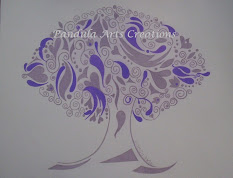+watermark.jpg)
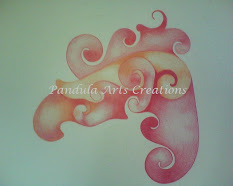+watermark.jpg)
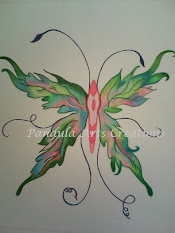+Watermark.jpg)
+watermark.jpg)
